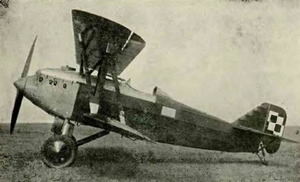The Bartel BM 6 was a Polish biplane trainer fighter aircraft of 1930. It did not advance beyond the prototype stage.
| Bartel BM 6 | |
|---|---|
 | |
| General information | |
| Type | Trainer aircraft |
| Manufacturer | Samolot |
| Status | Prototype |
| Primary user | Polish Air Force |
| Number built | 1 |
| History | |
| First flight | 8 April 1930 |
Design and development
editThe aircraft was designed by Ryszard Bartel in the Samolot factory in Poznań, as a trainer-fighter plane. The BM-6 prototype, designated BM 6a, was flown on 8 April 1930 in Poznań. Its advantage was an easy construction and maintenance, according to Bartel's design philosophy. A distinguishing feature of all Bartels was an upper wing of a shorter span, because lower and upper wing halves were interchangeable (i.e. the lower wingspan included the fuselage width). It first introduced a mixed construction to Bartel's designs.
After trials, the prototype was modified in July 1930. The prototype was later redesignated BM 6a/II after it was substantially modified. It offered quite good flight characteristics and was capable of aerobatic flight. It was demonstrated in a fighter-plane competition in Bucharest in 1930, along with the similar PZL P.1.
The second prototype BM 6b, with a Wright Whirlwind 220 hp radial engine, was ordered, but work upon it ceased with closure of the Samolot factory in mid-1930. The PWS works, which inherited many of Samolot's projects, did not continue the project, for it had its own similar design, the PWS-11.
Description
editMixed construction biplane. Steel framed fuselage, rectangular in cross-section, canvas covered (engine and upper sections - aluminum covered). Rectangular two-spar wings with rounded ends, plywood and canvas covered. Upper wing span: 7.36 m, lower wing span: 8.10 m. Lower and upper wing halves were interchangeable. Single pilot, sitting in open cockpit, with a windshield. The V8 engine Hispano-Suiza 8Be was modified to lower power output (from 220 hp to 180 hp). Radiator below the fuselage. Fixed landing gear, with a rear skid. Two-blade wooden propeller of fixed pitch. Fuel tank in fuselage: 168 L capacity.
Operational history
editAfter state trials in 1931, the prototype was used in an advanced training school in Grudziądz, then in an aviation training center in Dęblin.
Operators
edit- Polish Air Force (single prototype)
Specifications (BM 6a)
editData from Polish Aircraft 1893–1939[1]
General characteristics
- Crew: 1
- Length: 6.35 m (20 ft 10 in)
- Wingspan: 8.09 m (26 ft 7 in)
- Height: 2.8 m (9 ft 2 in)
- Wing area: 17.6 m2 (189 sq ft)
- Empty weight: 697 kg (1,537 lb)
- Gross weight: 985 kg (2,172 lb)
- Fuel capacity: 170 L (45 US gal; 37 imp gal)
- Powerplant: 1 × Hispano-Suiza 8Be V-8 water-cooled piston engine, 130 kW (180 hp)
- Propellers: 2-bladed Heine fixed pitch propeller
Performance
- Maximum speed: 194 km/h (121 mph, 105 kn) atsea level
- Never exceed speed: 420 km/h (260 mph, 230 kn)
- Service ceiling: 3,800 m (12,500 ft)
- Time to altitude: 4 minutes 24 seconds to 1,000 m (3,300 ft); 18 minutes 57 seconds to 3,000 m (9,800 ft)
- Wing loading: 56 kg/m2 (11 lb/sq ft)
- Power/mass: 0.138 kW/kg (0.084 hp/lb)
Armament
- Guns: 0.303 in (7.7 mm) Vickers machine gun in a fuselage, with a synchronising gear
See also
editAircraft of comparable role, configuration, and era
References
edit- ^ Cynk, Jerzy B. (1971). Polish Aircraft 1893–1939. London: Putnam. pp. 368-371. ISBN 978-0-370-00085-5.
Further reading
edit- Glass, Andrzej (1977). Polskie konstrukcje lotnicze 1893–1939 (in Polish). Warsaw: WKiŁ.
- Nelcarz, Bartolomiej & Peczkowski, Robert (2001). White Eagles: The Aircraft, Men and Operations of the Polish Air Force 1918–1939. Ottringham, UK: Hikoki Publications. ISBN 1-902109-73-2.
External links
edit- Photos and drawings
- Ugolok Neba site (in Russian)